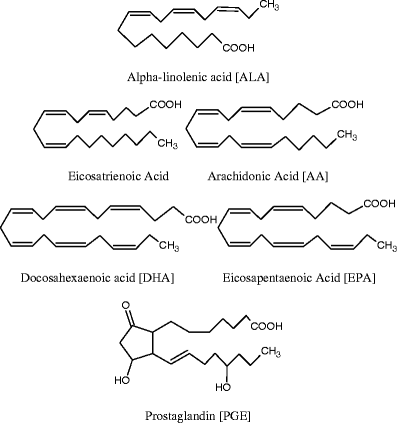Health effects of omega-3,6,9 fatty acids: Perilla frutescens is a good example of plant oils
- PMID: 21909287
- PMCID: PMC3167467
- DOI: 10.1007/s13596-011-0002-x
Health effects of omega-3,6,9 fatty acids: Perilla frutescens is a good example of plant oils
Abstract
Perilla frutescens seeds are a good source of polyunsaturated fatty acids (PUFAs). The seeds of perilla are small end globular weight about 4 g/1000, contained approximately 35-45% oil. However the leaves are a very poor source of oil, since they contain only 0.2%. In addition, only the seed oil contains the omega 3 fatty acid alpha-linolenic acid (ALA). In comparing to other plant oils, perilla seed oil consistently contains the one of the highest proportion of omega-3 (ALA) fatty acids, at 54-64%. The omega-6 (linoleic acid) component is usually around 14% and omega-9 (Oleic acid) is also present in perilla oil. These polyunsaturated fatty acids are most beneficial to human health and in prevention of different diseases like cardiovascular disorders, cancer, inflammatory, rheumatoid arthritis etc.
Figures






References
-
- Azcona JO, Schang MJ, Garcia PT, Gallinger C, Ayerza R, Coates W. Omega-3 enriched broiler meat: the influence of dietary alpha-linolenic omega-3 fatty acid sources on growth, performance and meat fatty acid composition. Can J Anim Sci Ott Ont Can. 2008;88:257–269.
-
- Bemelmans W, Broer J, Feskens E, Smit A, Muskiet F, Lefrandt J, Bom V, May J, Meybook-de Jong B. Effect of an increased intake of a-linolenic acid and group nutritional education on cardiovascular risk factors: the Mediterranean Alpha-linolenic Enriched Groningen Dietary Intervention (MARGARIN) study. Am J Clin Nutr. 2002;75(2):221–227. - PubMed
-
- Borchers AT, Hackman RM, Keen CL. Complementary medicine: a review of immunomodulatory effects of Chinese herbal medicines. Am J Clin Nutr. 1997;66(6):1303–1312. - PubMed
LinkOut - more resources
Full Text Sources
Other Literature Sources
